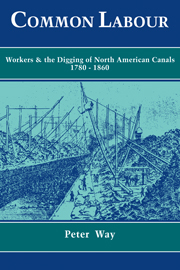Book contents
- Frontmatter
- Contents
- List of tables
- Acknowledgements
- Chronology of construction for main canals
- Abbreviations
- Map: Main canals of the North American Canal Era, 1780–1860
- Introduction
- 1 Early canals, 1780–1812
- 2 “As low as labor and capital can afford”: the contracting system, 1817–1840
- 3 “Human labor, physical and intelligent”
- 4 Payment “fit for labouring people”
- 5 The greatest quantity of labour
- 6 “Canawlers and citizens”
- 7 “Guerilla war”: labour conflict in the 1830s
- 8 “This new order of things”: the 1840s–1850s
- Conclusion
- Appendix 1 Tables 1–16
- Appendix 2 Tables 17–18
- Index
7 - “Guerilla war”: labour conflict in the 1830s
Published online by Cambridge University Press: 03 November 2009
- Frontmatter
- Contents
- List of tables
- Acknowledgements
- Chronology of construction for main canals
- Abbreviations
- Map: Main canals of the North American Canal Era, 1780–1860
- Introduction
- 1 Early canals, 1780–1812
- 2 “As low as labor and capital can afford”: the contracting system, 1817–1840
- 3 “Human labor, physical and intelligent”
- 4 Payment “fit for labouring people”
- 5 The greatest quantity of labour
- 6 “Canawlers and citizens”
- 7 “Guerilla war”: labour conflict in the 1830s
- 8 “This new order of things”: the 1840s–1850s
- Conclusion
- Appendix 1 Tables 1–16
- Appendix 2 Tables 17–18
- Index
Summary
I learned for to be very handy, to use both the shovel and spade,
I learnt the whole art of canalling, I think it an excellent trade.
I learnt to be very handy, although I was not very tall,
I could handle the sprig of shallelah, with the best man on the canal.
A “kind of guerilla war” raged along the line of the C&O Canal near the little town of Williamsport, Maryland, in late January 1834. “Armies” of Irish labourers numbering in the hundreds marched, made sorties against each other, and finally engaged in open battle. In the aftermath, witnesses “observed five men in the agonies of death, who had been shot through the head; several dead bodies were seen in the woods, and a number wounded in every direction. Those who observed the battle described it as one of great rage and most deadly violence.” Two factions were involved: the Fardowns, or Longfords, and the Corkonians, “composed respectively of those from the North and those from the South of Ireland.” Trouble had flared on Thursday the 16th when Corkonians assaulted Longford labourers, one of whom was beaten to death. His friends prepared for war, and the following Monday 200 attacked their opponents working six miles south of Williamsport. On the Friday, from 600 to 700 Far downers armed with guns, clubs and helves marched to a hill at Middlekauff's Dam, where 300 Corkonians, “armed, in part, with military weapons,” had assembled. Volleys of gunfire were exchanged and a pitched battle ensued. The outnumbered Corkonians were routed and hunted through the surrounding woods.
- Type
- Chapter
- Information
- Common LabourWorkers and the Digging of North American Canals 1780–1860, pp. 200 - 228Publisher: Cambridge University PressPrint publication year: 1993



